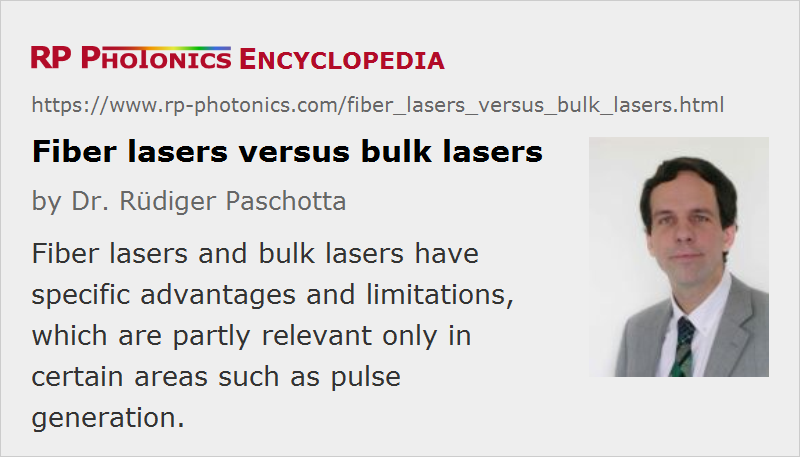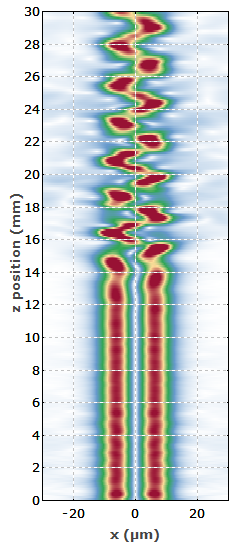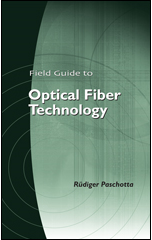Fiber Lasers Versus Bulk Lasers
German: Faserlaser vs. Bulk-Laser
Categories: fiber optics and waveguides, lasers
How to cite the article; suggest additional literature
Author: Dr. Rüdiger Paschotta
It is natural to compare different laser concepts with each other, in particular when they are used in overlapping application areas. This is particularly the case for two different kinds of solid-state lasers: bulk lasers and fiber lasers. There have been claims that fiber lasers, which have shown tremendous progress in recent years, will eventually replace most bulk lasers, since they could reach the same or better performance at a lower price. However, it is then overlooked that they also face a number of challenges, and depending on the specific goals these may outweigh the advantages. The outcome of such a comparison can thus depend strongly on various details of the specific requirements.
In recent years, global fiber lasers sales showed a significantly stronger growth than those of traditional solid-state lasers. However, the total turnover from fiber lasers is still smaller than that of other solid-state lasers (as of 2014). Their most important application areas are high-power laser material processing, laser marking and micro material processing. Less important application areas are in the military domain, fiber-optic sensors and medical lasers.
Technical Challenges of Fiber and Bulk Laser Devices
In the following, the most important aspects are briefly illuminated in order to permit a fair comparison of the concepts.
Basic Laser and Optical Properties
The moderate gain and pump absorption per unit length of rare-earth-doped fibers, caused by limitations to the doping concentration in glasses, requires the use of relatively long gain media, which has various consequences, as discussed below.
The long length and small effective mode area of fiber lasers lead to strong effects of the Kerr nonlinearity, despite the relatively small nonlinear index of fused silica (the most popular glass material for fibers). Particularly in the context of ultrashort pulse generation, but also for single-frequency lasers and amplifiers, excessive nonlinearity can have very detrimental effects. It often limits the achievable pulse duration or output power.
Most fiber lasers operate with high gain and high resonator losses. This makes them relatively immune to additional losses e.g. from various types of intracavity components. For example, a fiber laser resonator may well contain a grating pair for wavelength tuning without the efficiency being degraded too much by the introduced resonator losses. On the other hand, the small resonator losses of many bulk lasers make them interesting for intracavity frequency doubling and can lead to lower phase noise.
Many fiber devices are subject to problems with uncontrolled birefringence. It is not only that this often changes the polarization state from linear to elliptical; these changes are unfortunately dependent on temperature and bending. Many fiber lasers therefore may require readjustment of polarization controllers when the temperature changes. This may be acceptable for laboratory use, but often not for commercial devices. One does not always have the option to eliminate such problems by using polarization-maintaining fibers, since special fibers and fiber devices are often not available in this form, and e.g. mode locking with nonlinear polarization rotation would not work with a polarization-maintaining fiber.
Aspects Concerning High-power Devices
Both fiber and bulk lasers can generate multi-kilowatt powers. The power conversion efficiency (wall-plug efficiency) of fiber devices can be very high, and is often significantly better than that of bulk lasers. On the other hand, fiber devices require pump sources with a higher beam quality and brightness, compared with pump diodes for bulk lasers, generally increasing the price per watt of the pump source.
The geometry of fibers and their built-in waveguide effect essentially eliminate disturbing thermal effects (such as thermal lensing) and thus make it possible to achieve an excellent beam quality even at very high power levels. This is generally more difficult with bulk lasers, but some bulk laser concepts (in particular that of the thin-disk laser) have the potential for even higher single-mode powers.
Nonlinearities can limit the performance of high-power fiber devices in various ways, particularly in the context of pulse generation. A hard peak power limit in pulsed fiber devices is introduced by self-focusing. The Raman effect is also strong in fibers and can be a limiting factor also for high-power continuous-wave fiber lasers. In single-frequency operation, stimulated Brillouin scattering introduces severe limitations. All these limits are generally much less severe for bulk laser devices, where nonlinearities can be weaker by orders of magnitude.
Short Pulse Generation
Both fiber and bulk lasers can be Q-switched for generating nanosecond pulses. The shortest pulse durations are usually achieved with bulk lasers, as the gain per unit length is smaller for fiber devices. Also, fiber devices are limited in terms of peak power (see above).
High-power nanosecond laser systems based on fibers often contain some seed laser and a fiber amplifier, allowing for very high average power while still being limited in terms of peak power. In principle, very short seed pulses could be amplified, but the seed pulses often have to be made long enough to keep the peak power sufficiently low.
Ultrashort Pulse Generation
Fiber lasers are based on rare-earth-doped glass fibers, which offer a high amplification bandwidth compared with rare-earth-doped laser crystals. The fiber format allows the use of glasses without suffering from their lower thermal conductivity (because of the geometry and the waveguide effect) and their typically lower laser cross sections (because of the ease of obtaining a high gain in a fiber). As a result, fiber lasers can have very broad wavelength tunability and can generate very short optical pulses via passive mode locking. However, mode-locked fiber lasers often cannot utilize the full potential of the gain bandwidth in terms of pulse duration because of the detrimental effects of excessive nonlinearities and higher-order chromatic dispersion.
Fiber lasers can be mode-locked using nonlinear polarization rotation, which is an effective technique and less critical than additive-pulse mode locking of bulk lasers. However, such lasers are usually not long-term stable due to thermal variations of the birefringence (see above).
For fiber lasers with high (multi-gigahertz) pulse repetition rates, one usually requires the technique of harmonic mode locking, which makes the laser setup significantly more complicated than that of a compact bulk laser.
Sensitivity to Optical Feedback
High-power fiber devices for material processing are often very sensitive to optical feedback. One reason is that such devices are often master oscillator power amplifiers, so that the backreflected light is even amplified on its way back to the seed laser. In addition, the effective mode area is fairly small, so that fiber ends are easily destroyed. It is possible to use a Faraday isolator for preventing backreflected light from reaching the fiber, but this is not always practical, particularly at high power levels.
In many cases, one does not use an isolator, and then has to ensure that back-reflections are avoided e.g. by never allowing for normal incidence on a workpiece. This, however, can restrict the flexibility and possibly the processing quality.
Robustness and Cost
Simple fiber laser setups can be made from relatively cheap components, and they need fewer mechanical components. Ideally, a fiber laser setup should be made with fibers only, not involving any air space. Where this is possible, and processes such as fusion splicing of fiber components can be largely automated, fiber lasers can be significantly cheaper and smaller than bulk lasers. The output may then conveniently be delivered to a fiber connector, which allows easy connection to other devices without any alignment procedures.
However, the use of air spaces in fiber laser resonators often cannot be avoided, e.g. when certain bulk optical elements need to be inserted into the laser resonator, or fibers with very different mode areas are used and tapered fibers for mode area adaptation are not available. In such cases, the tight alignment tolerance of single-mode fibers and sometimes the high optical intensities at fiber ends may make the setup less robust than that of a bulk laser, and the cost may also not be low.
Maintenance is often not required by fiber devices. In the case of a defect, however, an all-fiber setup can make it relatively difficult to locate and exchange the defect part. On the other hand, it is easy to exchange fiber-optic components if fiber connectors are used.
The cost for developing a fiber-based laser system is often higher (as discussed in a Photonics Spotlight article), and the required time is longer. This is partly because it can be difficult to procure special parts, and sometimes (particularly for ultrafast lasers) because the operation principles of fiber lasers are more complicated than those of bulk lasers. Also, it is easier to combine different components in a bulk-optical setup, or to insert or remove parts for diagnostic reasons.
Uncertainties in Parameters
During the development of a laser system, difficulties can arise if relevant parameters of the gain medium are not known precisely.
For laser crystals as used in a bulk laser, there is a limited set of parameters such as doping concentration, spectroscopic data and geometric parameters. For common crystal materials, the uncertainties are usually small, whereas spectroscopic data are often uncertain for less common materials.
For rare-earth-doped fibers, the situation is generally less satisfactory. A first reason is that a fiber consists of glass material where the composition is less well defined. Even the manufacturer may not know exactly the amount of germanate in the core of a germanosilicate fiber, for example, and often the exact composition is not revealed to customers. In addition, a fiber has additional parameters such as the core diameter or refractive index profile which can be uncertain and vary between different samples.
Some Guidelines
Some general guidelines for determining in which areas fiber lasers or bulk lasers may be stronger are as follows:
- Fiber lasers are suitable for generating very high average powers with high beam quality. This holds particularly for unusual wavelengths, where no good bulk crystals or glasses are available. Fiber lasers are clearly superior for difficult lasing schemes such as low-gain transitions or upconversion. However, bulk lasers are required for some other spectral regions; for example, there is no fiber laser to replace a broadly tunable Ti:sapphire laser in the region of 700–1000 nm.
- Bulk lasers have a higher potential for high pulse energies and peak powers either with Q switching or with mode locking.
- Bulk lasers can utilize pump sources with very poor beam quality. In the most extreme case, a side-pumped rod laser can be pumped with discharge lamps. This can be advantageous e.g. when very high peak powers in pulses with moderate repetition rates are required.
- Bulk lasers are often preferable when a stable linear polarization is required (and polarization-maintaining fibers can not be used for some reason).
- For ultrashort pulse generation, bulk lasers make it easier to achieve a high peak power and a high pulse quality in terms of smooth spectral shape, low chirp and low background.
- In terms of fabrication cost, fiber lasers will often be superior for devices with low demands on peak power, polarization, emission bandwidth, pulse quality, etc. However, more stringent demands of such type can often favor a bulk laser, as a fiber device would require complicated additional measures or very special parts. Also, the often higher development cost of fiber-based devices can be a problem in cases with small sales numbers.
The points discussed show clearly that both bulk and fiber lasers have significant advantages and disadvantages, so that one or the other concept can be superior depending on the particular circumstances.
Questions and Comments from Users
Here you can submit questions and comments. As far as they get accepted by the author, they will appear above this paragraph together with the author’s answer. The author will decide on acceptance based on certain criteria. Essentially, the issue must be of sufficiently broad interest.
Please do not enter personal data here; we would otherwise delete it soon. (See also our privacy declaration.) If you wish to receive personal feedback or consultancy from the author, please contact him e.g. via e-mail.
By submitting the information, you give your consent to the potential publication of your inputs on our website according to our rules. (If you later retract your consent, we will delete those inputs.) As your inputs are first reviewed by the author, they may be published with some delay.
See also: fiber lasers, bulk lasers, solid-state lasers, high-power lasers, high-power fiber lasers and amplifiers, mode-locked fiber lasers, The Photonics Spotlight 2011-02-10
and other articles in the categories fiber optics and waveguides, lasers
 |






If you like this page, please share the link with your friends and colleagues, e.g. via social media:
These sharing buttons are implemented in a privacy-friendly way!